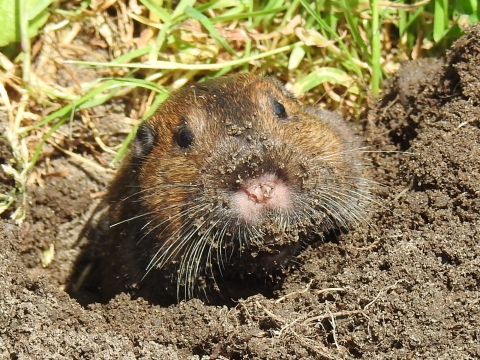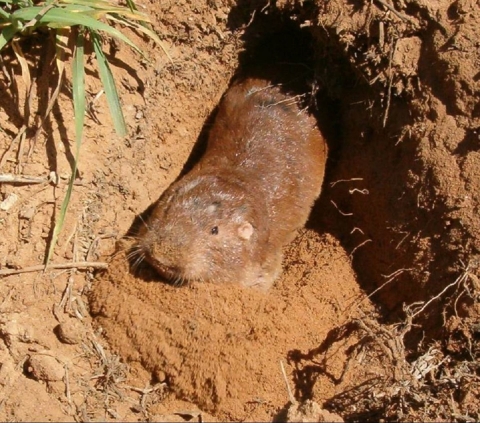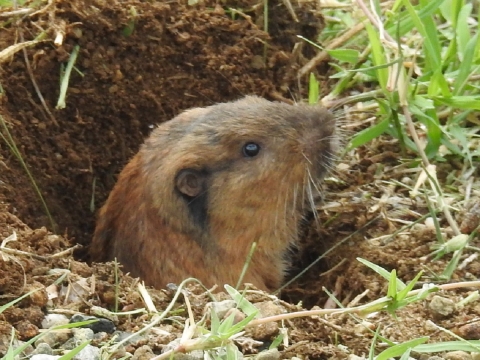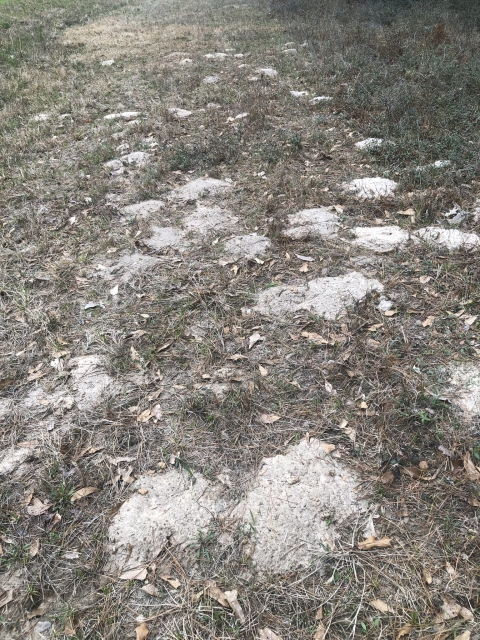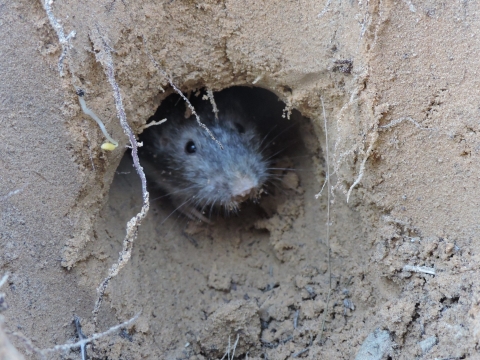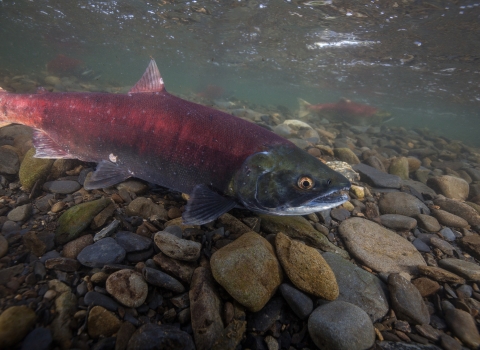They’ve starred in Hollywood movies. They look like furry potatoes. Scientists call them “ecosystem engineers” for their profound impact on the habitat and resources of bugs, plants and other animals.
“They’re amazing little mammals that don't get nearly enough positive attention,” said Sam Kieschnick, urban wildlife biologist with the Texas Parks and Wildlife Department. “The more you learn about their biology, the more you appreciate them. And not only are pocket gophers interesting – they're essential.”
Kieschnick has a master’s degree in the genetics of pocket gophers from Tarleton State University. He is also one of the top 10 iNaturalist observers in the world, with more than 100,000 observations including hundreds of pocket gophers.
“They’re close to my heart,” Kieschnick said. “Whenever I'm driving anywhere throughout Texas, or outside of Texas, if I see these little gopher mounds, I'll pull the car over.”
By the end of this article, you might start getting excited to see gopher mounds, too. Keep reading for a glimpse into the fascinating world of pocket gophers in Texas and beyond.
Some Are Uniquely Texan
Pocket gophers in Texas may look similar to those found in California, but not only are there different species in each state, there can even be different species and subspecies in each county.
“Gophers only live underground and they don’t fly around or migrate,” Kieschnick said. “Some species were probably a continuous population but then over time either a creek developed, a river developed, or some geologic change occurred, and they became a different species.”
Depending on who you ask, Texas is home to around 11 of the roughly 41 species of pocket gophers. Eight can also be found in neighboring states and Mexico like the yellow-faced pocket gopher, Botta’s pocket gopher, desert pocket gopher, Baird’s pocket gopher, plains pocket gopher, Texas pocket gopher, Hall’s pocket gopher, and Jones’s pocket gopher.
Three are unique to Texas and occur nowhere else in the world: the Strecker’s pocket gopher, known only from Dimmit and Zavala counties, the Llano pocket gopher, known only from two isolated areas of the Texas Hill Country, and Attwater’s pocket gopher, known only in South Texas and the coast.
“They are the little remnant of what once was a continuous species,” Kieschnick said. “But now they have their own little island in that part of Texas and in that soil of Texas, and some of them are super tiny populations.”
Some of these pocket gopher species can be distinguished visually. According to Kieschnick, pocket gophers in West Texas near Monahans Sandhills State Park tend to be more of a light blonde so that they can blend into the sand dunes and avoid predators. The species he studied, Baird’s pocket gopher, tends to be a little bit darker to blend in with the darker soils of East Texas.
Some of the species can only be identified by DNA, because while they are still very similar in appearance to their close relatives, they’ve been living and evolving in isolation for thousands of years.
They Have Ride-Or-Die Sidekicks
Outside of mating and a brief period spent raising their young, pocket gophers prefer solitude. But they aren’t the only isolated, genetically distinct creatures that live in their burrows.
The wingless chewing lice that live on the head, neck and back of pocket gophers, Geomydoecus, spend their entire life cycle on the burrowing animals. These chewing lice, which do not tend to have a negative impact on pocket gophers, are host-specific, meaning they can only live on a particular species of host.
Not only can they only live on that one species of host, but they also actually evolved in tandem with it, which scientists call cospeciation. For instance, the Llano pocket gopher, Geomys texensis, carries around its own little chewing lice species, Geomydoecus heaney.
Though other ectoparasites live on pocket gophers, like mites and fleas, the chewing lice are the most studied. Because pocket gopher species are so isolated from one another, scientists have found that studying them and their chewing lice is an “ideal system for the study of coevolutionary relationships between hosts and their parasites.”
They’re Neat Freaks
Don’t let the chewing lice or life spent digging in the dirt fool you, because pocket gophers are actually very clean animals.
First, they take food safety very seriously. When scientists studied pocket gophers in a lab, they observed the critters drying and cleaning wet and dirty leaves before eating them by shaking them rapidly or running them through their hands. In some cases, they found that more time is spent cleaning the food than eating it, and only saw occasional sand grains when examining the stomach samples of the animals.
Second, pocket gophers are crazy about personal hygiene and grooming. The same scientists who noted their cleanliness with food also found the lab animals were quick to dry themselves when wet, frequently used their claws to stroke and clean their long teeth, and groomed themselves regularly “in the fashion of a cat” by licking their forelimbs with their tongues and rubbing their face, neck, and ears.
They’re Talented Homemakers
Pocket gophers should be commended for their ability to make a house a home.
Pocket gopher burrow systems are surprisingly well thought out and consist of a variety of different rooms with different purposes, much the same as the ones we build for ourselves. Pocket gophers have vegetation-lined food storage rooms, nurseries for their young, latrines that can be periodically plugged for sanitation purposes, and nesting rooms for sleeping and leisure.
Additionally, a large portion of the burrow consists of a feeding tunnel parallel to the surface of the ground. Since pocket gophers are vulnerable to predators and rarely leave their burrows, the feeding tunnel allows them to pull down roots and vegetation from the surface into the safety of their homes.
Though the dark, cozy spaces they live in might sound welcoming, don’t invite yourself in for a cup of tea. Some species of pocket gophers have been described as “extremely pugnacious.”
“A lot of critters that live by themselves outside of a colony tend to be pretty defensive,” Kieschnick said. “That's kind of a biological aspect of their solo lives.”
They’re Hoarders
They may be pocket-sized, but that’s not why they’re called pocket gophers. They actually have little pockets on their face that they use to carry stuff around.
These fur-lined, external cheek pouches are used to transport nesting materials to enhance the coziness of their subterranean homes as well as food to hoard in their storage rooms. Pocket gophers are active year-round, but the extra food storage allows them to have plenty of options available during lean times.
In keeping with their overall cleanliness, pocket gophers can close their lips behind their teeth to keep dirt and debris out of their throats as they dig and carry stuff around. They can also turn their cheek pouch inside out so that they can thoroughly clean it with their tongue and claws.
They’re Jacked
Just because they are shaped like tiny beer kegs it doesn’t mean they aren’t strong. While some gopher species use their teeth to dig in compact soils, many use their strong forelimbs and hind-limbs to dig. That’s why gophers are called fossorial mammals, meaning they are adapted to digging and live primarily underground.
“They're built,” Kieschnick said. “Their pectoral muscles, biceps and triceps are amazing. That goes back to their lifestyle – it’s that constant scratching in the soil.”
In fact, burrowing is one of the most energy intensive activities that an animal can do, requiring up to 3,400 times as much energy as moving the same distance across the surface.
They’re Ecosystem Engineers
Pocket gophers occur in grassland habitats in almost half of North America and influence these ecosystems in diverse ways, including through digging tunnels, munching on plants, and serving as a food source for predators. Not only that - even their latrines provide nutrients in the soil!
Scientists have estimated that tunneling activity and digging by a single gopher can move around 18 pounds of soil every year, making them excellent “soil engineers.” Gopher mound soil not only has more nutrients compared to surrounding undisturbed soil, but the mounds themselves can also promote plant diversity by providing space for plants that have trouble competing with more aggressive species.
“A healthy, sandy prairie needs gophers,” Kieschnick said. “If it doesn't have gophers, I would argue it's not as healthy as one that does, because of the constant aeration of soil. There's not really any other critter that does it to the extent that gophers do it.”
By foraging in productive patches of plants, gophers help more light penetrate the canopy and positively impact the soil nitrogen levels in the ground by reducing biomass.
They also have impacts on other animals, increasing the abundance of grasshoppers, providing homes for some bee species, amphibians, reptiles and other mammals with their abandoned burrows, and serving as a large portion of the diet of a variety of birds, mammals, and snakes including great blue herons and owls, coyotes, and Louisiana pinesnakes.
“Because they are this ecosystem engineer, and because they are fed upon by so many things, and because so many things live with gophers, it’s a good thing to see gophers around,” Kieschnick said. “The foundation of ecosystem health is based on biodiversity. So the more species that you have in an area, the healthier it is and the more ecosystem services that are provided.”
They’re Doing OK
In Texas, pocket gophers are not listed on either the state or federal list of threatened and endangered species. But some of the species that only live in isolated areas of Texas are considered Species of Greatest Conservation Need (SGCN), which is a list compiled by TPWD to identify native animals and plants that are declining or rare and in need of attention.
“Most of the critters on that list are those unknown, unappreciated little tiny things that really make the whole world go round,” Kieschnick said. “Many of them are narrowly endemic, so they're found just in this little section of Texas. These are our species and are found nowhere else on the planet. That's important.”
TPWD’s Texas Conservation Action Plan focuses on the species on this list, with the primary purpose of bringing people together to realize conservation benefits, preventing species listings, and preserving the natural heritage of Texas for future generations.
They Remind Us That Beauty Lies Below the Surface
Since we live in the bright, colorful world above ground, it can be hard to remember that a whole other world thrives beneath us. But Kieschnick says this underground world should get more credit.
“The stuff that lives underground is the foundation for everything that lives above ground,” Kieschnick said. “There's a whole ecosystem that exists underground with little tiny microbes, worms, nutrients, gophers, and all of these things that exist underneath the soil surface.”
“Because we're so visual it's hard for us to perceive something that can't really be seen,” he added. “But that ecosystem of the soil and of all of these subterranean critters is so important for us to remember. And I think there's beauty underneath that.”


